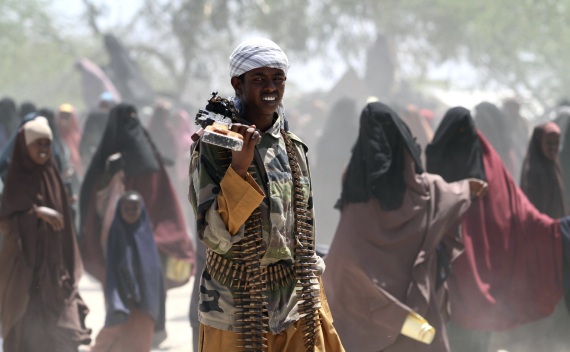Somalia: Kenya’s Invasion and Objectives
More on:

When political leaders call for the application of military force, it is a useful to assess the intended political and military objectives. Quite often, those objectives are reactionary, ephemeral, or unachievable given the resources committed and the political will of decisionmakers. The unexpected invasion by Kenyan forces into Somalia to defeat the notorious militant group, al-Shabaab, offers such an opportunity to analyze the motives and potential outcomes of this use of force.
What are the intended objectives of the Kenyan military in Somalia?
On October 16, government spokesperson Alfred Mutua said Kenyan troops are "pursuing al-Shabaab across the border." A few days later, he claimed that the Kenyan military would “track down and dismantle the al-Shabaab.” Meanwhile, an anonymous Kenyan official declared, “They’re going all the way to Kismayo [an al-Shabaab-controlled port 155 miles from the Kenyan border]. We’re going to clear the Shabaab out.”
The rapid escalation of military objectives leads to another question: why exactly did Kenya invade Somalia?
The invasion was initially justified as a response to three kidnappings of westerners in northern Kenya over the past month. Two of those kidnapping attempts resulted in the deaths of a fifty-eight year old British tourist and a sixty-six year old disabled French tourist.
It is understandable that Kenya would seek to protect its tourist industry, which has seen its revenues grow by one-third to $737 million since the post-election violence of 2008. Moreover, the specific threat to Westerners is concerning since they make up the overwhelming majority of tourists who vist Kenya.
However, yesterday Mr. Mutua admitted that the kidnapping rationale was actually a “good launchpad,” and that plans for the invasion had “been in the pipeline for a while.” Another anonymous senior Kenyan official added: “This isn’t about tourism. This is about our long-term development plan. Kenya cannot achieve economically what it wants with the situation the way it is in Somalia.”
What is the likelihood of successfully achieving the intended objectives?
The strength of al-Shabaab militants, who are suspected of kidnapping Western tourists, ranges from 3,000 to an unbelievably specific 14,426. In August, al-Shabaab withdrew from Mogadishu to avoid direct combat with the 8,000 AMISOM troops stationed there. Since then, al-Shabaab has re-focused its insurgent activities against the Transitional Federal Government and international aid agencies to the west and south of the capital. The UN Secretary General’s latest report on Somalia noted that al-Shabaab “maintained a significant presence in the [Gedo and Juba] regions” of southern Somalia bordering Kenya. The report also correctly predicted that “al-Shabaab’s use of terrorist tactics and asymmetric warfare is likely to increase.”
Within less than two weeks of fighting, approximately 1,500 Kenyan troops backed by tanks and helicopter gunships—with the support of some Somali militias—have captured Shabaab-controlled towns and forced the insurgents to temporarily disperse. However, due to heavy seasonal rains, the logistical support required to sustain and advance Kenyan troops has become overwhelmed. Given the relatively modest commitment of forces, as well as the stated opposition to the invasion by the internationally-recognized Somali President, Sharif Sheik Ahmed, it is inconceivable that Kenyan forces will permanently “clear out” al-Shabaab, much less prevent their return.
What support is Kenya receiving from the United States?
Initially, many believed that Kenya coordinated its invasion with the Pentagon, in a similar fashion as Ethiopia in December 2006, when the United States provided detailed intelligence, military training, and naval support. This perception was further reinforced when the U.S. ambassador to Kenya, Scott Gration, told the Financial Times: “We are looking to see how, as an ally in this conflict on terrorism, can we help the Kenyans.”
However, several U.S. officials have explicitly denied coordination with the Kenyan military or any contribution of direct military support. An unnamed senior U.S. official noted the absence of “U.S. military strikes in Somalia at all recently.” The State Department clarified the official U.S. position on October 25, stating: “The United States is not participating in Kenya’s current operation in Somalia.”
Over the past three decades of civil war in Somalia, the international community has been consistently allured by the use of military force to “solve” the myriad problems related to humanitarianism, piracy, terrorism, and—most recently—tourism. Although all attempts thus far have failed, it hasn’t prevented the idea from resurfacing.
In late 2008, the Bush administration debated using naval cruise missiles and drone strikes against on-shore bases in Somalia with the intended objective of ending the persistent problem of piracy. When asked his opinion of such options, Vice Admiral William Gortney, then-commander of the U.S. 5th Fleet, warned: "I see people trying to look for an easy military solution to a problem that demands a nonkinetic solution." When assessing Kenyan objectives in Somalia, history repeats itself.
More on:
 Online Store
Online Store